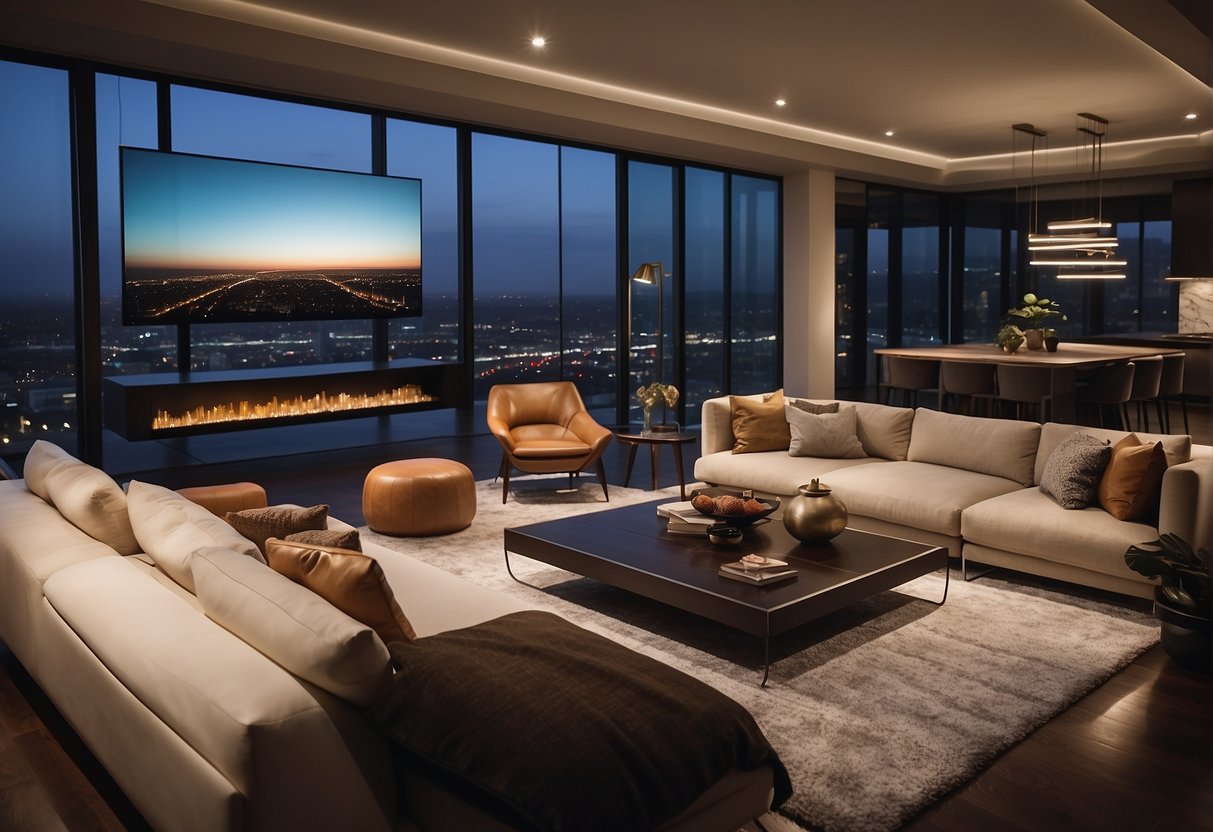Blending High-Tech Comfort with Design
Smart home technology has become an indispensable part of modern living. With the advent of devices that can learn from our habits and anticipate our needs, the definition of home is transforming. Convenience and innovation are at the forefront, allowing for the seamless management of home environments. From controlling lighting and temperature with a simple voice command to receiving alerts when groceries are running low, technology is not just an add-on but is increasingly integrated into the very fabric of home design.

Integrating smart technology into homes is appealing to the tech-savvy getting started on their journey into this connected way of life. The appeal lies beyond mere gadgetry; there is a deep-seated desire for efficiency and a personalized living space that adapts to one’s lifestyle. It’s a world where your morning coffee is brewed just as you step out of bed and the lights dim as you settle down with a book, all without lifting a finger.
The smart home market is ever-evolving, driven by newer, more advanced technologies that promise to make life even easier and homes more intelligent. This tide of constant innovation means that homes not only respond to commands but also anticipate the inhabitants’ needs, learning from their behaviors to create a truly intuitive living experience. As the market grows, it’s clear that the smart way of living is here to stay, becoming a fundamental part of how modern homes are designed and enjoyed.
Designing with Technology in Mind

When designing a home with smart technology, one must consider not only the functionality but also how it complements the interior design. Innovations should enhance living spaces both practically and visually, ensuring that tech elements integrate seamlessly.
Innovative Home Layouts
Designing a home layout with smart technology demands a forward-thinking approach. Interior designers often emphasize the importance of flexible spaces that can adapt to evolving tech. A room might feature built-in smart screens or voice-controlled ambient lighting, creating an interactive environment that’s both functional and futuristic.
Aesthetics and Smart Tech Integration
The aesthetics of smart technology in the home should enhance the overall ambiance without disrupting it. Invisible speakers, for example, can blend effortlessly into the decor, providing high-quality sound while maintaining the visual flow of the space. Designers are tasked with incorporating technology that both aligns with the homeowner’s vision and contributes positively to the aesthetics of the space.
Furniture and Fixtures for the Tech-Savvy
Furniture and fixtures must evolve with the increase in smart home technology. A coffee table might come equipped with charging ports, yet retain a sleek and stylish design. Couches and chairs could offer concealed compartments for tech devices, allowing for convenience without sacrificing the integrity of the room’s design options and decor.
Core Smart Home Technologies

Smart home technologies enhance modern living by providing convenience, efficiency, and security. They allow homeowners to control and monitor their homes with ease and sophistication.
Thermostats and Climate Control
Smart thermostats are at the heart of home HVAC automation, providing intelligent temperature control. These devices learn from a homeowner’s patterns and adjust the climate accordingly, often leading to energy savings.
Intelligent Lighting Solutions
With smart lighting systems, users can customize the ambiance of any room. These systems not only allow for the remote adjustment of brightness but also can change light color. Lights can be scheduled or triggered by events, contributing to both the aesthetic and security of a home.
Advanced Security Systems
Contemporary smart homes often feature advanced security systems, which include smart doorbells equipped with cameras and security cameras that offer real-time monitoring and alerts. They provide homeowners peace of mind by securing entry points and allowing them to monitor their homes remotely.
Control and Automation

As homes get smarter, control and automation become simpler and more intuitive. Homeowners can now manage their living spaces with greater ease, tapping into ecosystems that are voice-activated and personalized to their needs.
Voice Command Ecosystems
The rise of voice command platforms like Amazon Echo and Google Home has revolutionized home automation. These ecosystems allow users to employ simple voice commands to control various aspects of their home. For instance, saying “Alexa, dim the living room lights” or “Hey Google, play some jazz music” can trigger immediate actions, providing convenience and a seamless connection between the user and the smart devices.
Hands-Free Convenience Features
Hands-free features enhance day-to-day living by incorporating elements like motion sensors and connectivity to anticipate a homeowner’s needs. Imagine walking into a room and having the lights turn on automatically or the thermostat adjust to the perfect temperature—these are the realities of a smart home equipped with automation features tailored for ease and efficiency.
Customization and Personalization
Customization takes the smart home experience to the next level. Homeowners can create scenes or set routines tailored to their lifestyles, such as programming a “Good Morning” scene that opens blinds, starts the coffee machine, and reads out the day’s appointments. Personalization with voice assistants extends beyond mere convenience; it ensures that each interaction with the smart home system fits the unique preferences and habits of the user.
By focusing on control and automation, technology is reshaping the modern home into a hub of connectivity and personalized convenience.
Smart Entertainment and Living

In today’s smart homes, entertainment has transcended mere watching and listening—it’s about immersive experiences and seamless integration with the living environment. Homeowners are leveraging cutting-edge technology to elevate their leisure time.
Home Theaters and Audio Systems
A proper home theater system envelops they in cinematic luxury, with 4K HDR projectors and multi-channel surround sound that rivals any movie theater. Smart audio systems are key, laced through multiple rooms and controlled with a voice command or a smartphone app. They can stream a favorite podcast as easily as they set the scene with a curated playlist for dinner parties, all through smart speakers that integrate flawlessly into Apple Home or similar ecosystems. The ease of connectivity brings every beat and dialogue straight into the comfort of their living room.
Gaming and Streaming
For those who are keen gamers, the integration of gaming systems with smart home technology provides a custom, responsive, and utterly engaging experience. Streaming devices ensure that they never miss the latest game or TV show, providing access to services like Netflix, Amazon Prime, or Hulu in a few simple clicks. It’s not just convenience; it’s about delivering high-quality content in the format that suits their lifestyle, consistently and reliably. Whether they’re into multiplayer gaming marathons or catching up on the latest bingeworthy series, their smart home is equipped to deliver endless entertainment options.
Beyond Convenience: Safety and Efficiency
Smart home technology goes far beyond simple convenience; it plays a critical role in enhancing safety and promoting efficiency throughout the household. Homeowners can capitalize on technology that boosts sustainability, energy efficiency, and accessibility while ensuring a reliable safety net.
Energy Management
Energy-efficient technology is at the forefront of smart home integration. Smart appliances are designed not only to streamline daily tasks but also to lessen energy consumption significantly. Take, for instance, thermostats that learn a user’s schedule to optimize heating and cooling, or lighting systems that adjust according to natural light levels to reduce unnecessary power use. These advances contribute to a sustainability dynamic within the modern home, cutting down on both energy bills and environmental impact.
Home Safety Innovations
The safety aspect of smart homes is multi-faceted. Today, owners can install smoke detectors that alert them to fire hazards well before traditional alarms would. Innovative smart locks and doorbell cameras add layers of security by allowing remote monitoring and control over who has access to the home. Integrating AI into these systems further enhances their reliability, making safety not just a feature but a foundation of smart home living.
Accessibility for Everyone
Smart home technology champions accessibility. Features like voice-controlled systems and automated interfaces present a powerful advantage for those with mobility challenges or disabilities. They can effortlessly control settings, from temperature to entertainment, creating an environment where everyone, regardless of physical capability, can experience the benefits of a high-tech, efficient household. These technological advances ensure that the smart home realm is inclusive, aligning with broader societal goals of accessibility for all.





